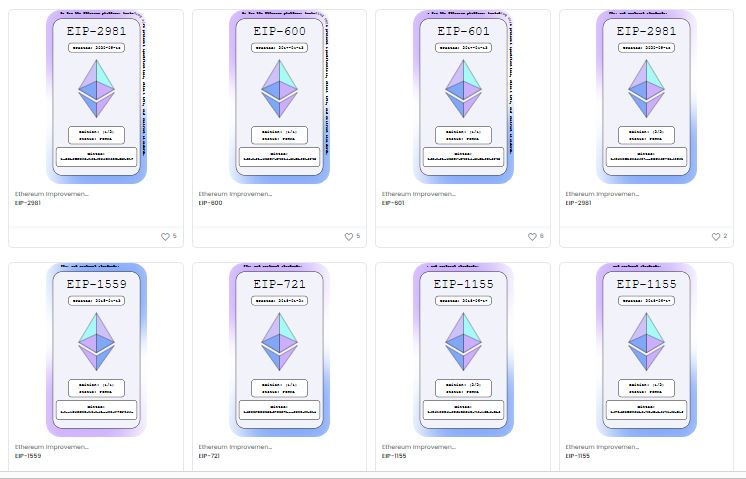Reason to trust

How Our News is Made
Strict editorial policy that focuses on accuracy, relevance, and impartiality
Ad discliamer
Morbi pretium leo et nisl aliquam mollis. Quisque arcu lorem, ultricies quis pellentesque nec, ullamcorper eu odio.
Introducing the EIP NFTs. Only authors of finalized Ethereum Improvement Proposals can mint these new NFTs that represent their contributions to Ethereum as a whole. This is a way to, not only recognize, but retroactively fund the work of the developers and philosophers that make the Ethereum ecosystem what it is. How will the market value these EIP NFTs? That’s what the experiment is about.
Related Reading | Why This Crypto Billionaire Abandoned Ethereum
Before we get into EIP NFTs, what’s an Ethereum Improvement Proposal? According to the project’s documentation:
“Ethereum Improvement Proposals (EIPs) are standards specifying potential new features or processes for Ethereum. EIPs contain technical specifications for the proposed changes and act as the “source of truth” for the community. Network upgrades and application standards for Ethereum are discussed and developed through the EIP process.”
4/ Each NFT that gets minted implements #ERC2981 which means that royalties will be paid in perpetuity to the minting address (i.e. EIP author).
The artwork is heavily inspired by @Uniswap v3 LP NFTS by @crypt0glitter. You can see the collection here: https://t.co/ba5hBSH7n0
— blaine (@blainemalone) November 17, 2021
Retroactive Public Goods And The Results Oracle
Before we get to EIP NFTs, we have to explore the Retroactive Public Goods idea. As with everything in the Ethereum ecosystem, this comes from the mind of Vitalik Buterin. “The core principle behind the concept of retroactive public goods funding is simple: it’s easier to agree on what was useful than what will be useful,” Vitalik explains in the article that poses the idea. The Optimism PBC organization expands on it:
“So… what would happen if suddenly, exits did exist for public goods projects? An exit determined by how much public good has been created by the project rather than quarterly profit. Would we see more vigorous investment and innovation on technology that maximizes community benefit? Would we see more nonprofits thriving rather than surviving?”
We're LIVE on Ethereum mainnet! 🎉
EIP Authors can now claim their EIP NFTs representing their contributions.https://t.co/zMgKr3eWVC
— aka labs (@aka_labs_) November 17, 2021
How to answer those rhetorical questions? The article offers a solution, again in Vitalik’s own words.
“A DAO, which we can call “the Results Oracle”, funds public good projects. Long term, the results oracle can be funded by protocol fees (eg. if implemented by an L2 project, sequencer auctions are one candidate). But unlike other public goods funding DAOs, the Results Oracle funds projects retroactively, rewarding projects that it recognizes as having already provided value.”

ETH price chart for 11/24/2021 on FTX | Source: ETH/USD on TradingView.com
What Are The EIP NFTs, then?
The people behind the AKA Labs took the Retroactive Public Goods concept and stripped it of complications. They developed a first implementation that doesn’t need to raise funds or to create a DAO. Let’s read their explanation.
“Acknowledging the fact that building a fully functional “results oracle” would be a large undertaking. This project dips its toes in and tries to shine a light on the space.
The fun part of this experiment is observing how the market decides to value each EIP NFT. We fully encourage EIP authors to mint their NFT/NFTs and participate in the experiment.”
To mint EIP NFTs “users must prove that they’ve authored/co-authored an EIP.” So far, nine of them exist, but they haven’t produced any financial activity. This is where the Ethereum community comes into play. The process of valuation starts with them. By making offers and funding the retroactive recognition themselves, they will define how much each of the NFTs is worth. Will the most important proposals get a higher valuation? Or will the community value them all similarly?
Related Reading | Christie’s Will Auction Original Art From Gary Vee‘s Veefriends NFT Collection
It’s worth noting that “each NFT that gets minted implements #ERC2981 which means that royalties will be paid in perpetuity to the minting address.” The minting goes through the EIP’s author address, AKA labs don’t get a cut. The project is a nonprofit, just like the projects they’re trying to help thrive.
Will the EIP NFTs experiment succeed or fall by the wayside? That’s for the Ethereum community to decide.
Featured Image: Screenshot from the EIP NFTs Open Sea page | Charts by TradingView



























